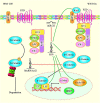Emerging Role of Non-Coding RNAs in Senescence
- PMID: 35865636
- PMCID: PMC9294638
- DOI: 10.3389/fcell.2022.869011
Emerging Role of Non-Coding RNAs in Senescence
Abstract
Senescence is defined as a gradual weakening of functional features of a living organism. Cellular senescence is a process that is principally aimed to remove undesirable cells by prompting tissue remodeling. This process is also regarded as a defense mechanism induced by cellular damage. In the course of oncogenesis, senescence can limit tumor progression. However, senescence participates in the pathoetiology of several disorders such as fibrotic disorders, vascular disorders, diabetes, renal disorders and sarcopenia. Recent studies have revealed contribution of different classes of non-coding RNAs in the cellular senescence. Long non-coding RNAs, microRNAs and circular RNAs are three classes of these transcripts whose contributions in this process have been more investigated. In the current review, we summarize the available literature on the impact of these transcripts in the cellular senescence.
Keywords: biomarker; epigenetics; expression; lncRNA; miRNA; senescence.
Copyright © 2022 Ghafouri-Fard, Khoshbakht, Hussen, Baniahmad, Branicki, Taheri and Eghbali.
Conflict of interest statement
The authors declare that the research was conducted in the absence of any commercial or financial relationships that could be construed as a potential conflict of interest.
Figures





Similar articles
-
MicroRNAs, Long Non-Coding RNAs, and Circular RNAs in the Redox Control of Cell Senescence.Antioxidants (Basel). 2022 Feb 28;11(3):480. doi: 10.3390/antiox11030480. Antioxidants (Basel). 2022. PMID: 35326131 Free PMC article. Review.
-
The Interaction Between Non-Coding RNAs and Calcium Binding Proteins.Front Oncol. 2022 Mar 4;12:848376. doi: 10.3389/fonc.2022.848376. eCollection 2022. Front Oncol. 2022. PMID: 35317077 Free PMC article. Review.
-
Non-coding RNAs as Regulators of Cellular Senescence in Idiopathic Pulmonary Fibrosis and Chronic Obstructive Pulmonary Disease.Front Med (Lausanne). 2020 Dec 23;7:603047. doi: 10.3389/fmed.2020.603047. eCollection 2020. Front Med (Lausanne). 2020. PMID: 33425948 Free PMC article. Review.
-
Regulatory Role of Non-Coding RNAs on Immune Responses During Sepsis.Front Immunol. 2021 Dec 9;12:798713. doi: 10.3389/fimmu.2021.798713. eCollection 2021. Front Immunol. 2021. PMID: 34956235 Free PMC article. Review.
-
Implication of non-coding RNA-mediated ROCK1 regulation in various diseases.Front Mol Biosci. 2022 Sep 13;9:986722. doi: 10.3389/fmolb.2022.986722. eCollection 2022. Front Mol Biosci. 2022. PMID: 36177350 Free PMC article. Review.
Cited by
-
Senescence and fibrosis in salivary gland aging and disease.J Oral Biol Craniofac Res. 2024 May-Jun;14(3):231-237. doi: 10.1016/j.jobcr.2024.02.009. Epub 2024 Mar 13. J Oral Biol Craniofac Res. 2024. PMID: 38516126 Free PMC article.
-
The Intersection of Epigenetics and Senolytics in Mechanisms of Aging and Therapeutic Approaches.Biomolecules. 2024 Dec 26;15(1):18. doi: 10.3390/biom15010018. Biomolecules. 2024. PMID: 39858413 Free PMC article. Review.
-
Genetic and Epigenetic Interactions Involved in Senescence of Stem Cells.Int J Mol Sci. 2024 Sep 7;25(17):9708. doi: 10.3390/ijms25179708. Int J Mol Sci. 2024. PMID: 39273655 Free PMC article. Review.
-
The Association Between Sarcopenia and Diabetes: From Pathophysiology Mechanism to Therapeutic Strategy.Diabetes Metab Syndr Obes. 2023 May 30;16:1541-1554. doi: 10.2147/DMSO.S410834. eCollection 2023. Diabetes Metab Syndr Obes. 2023. PMID: 37275941 Free PMC article. Review.
-
microRNAs Associated with Carotid Plaque Development and Vulnerability: The Clinician's Perspective.Int J Mol Sci. 2022 Dec 9;23(24):15645. doi: 10.3390/ijms232415645. Int J Mol Sci. 2022. PMID: 36555285 Free PMC article. Review.
References
-
- Asadi M. H., Yaghoobi M. M. (2018). Long Noncoding RNA VIM-AS1 Promotes Colorectal Cancer Progression and Metastasis by Inducing EMT. Eur. J. Cell Biol. 97 (4), 279–288. - PubMed
-
- Auler M., Bergmeier V., Georgieva V. S., Pitzler L., Frie C., Nüchel J., et al. (2021). miR-127-3p Is an Epigenetic Activator of Myofibroblast Senescence Situated within the MicroRNA-Enriched Dlk1-Dio3‒Imprinted Domain on Mouse Chromosome 12. J. Investigative Dermatology 141 (4), 1076–1086. e3. 10.1016/j.jid.2020.11.011 - DOI - PubMed
Publication types
LinkOut - more resources
Full Text Sources

